Monthly Stars for Your Garden
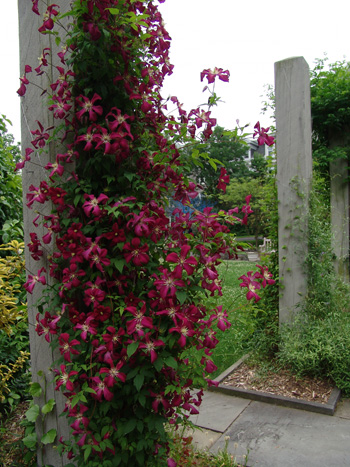 One way to approach your garden design is to say “I want to have a garden star every month—a spotlight bloom, something to catch your eye, a flower that attracts attention.”
One way to approach your garden design is to say “I want to have a garden star every month—a spotlight bloom, something to catch your eye, a flower that attracts attention.”
Scott Arboretum Curator Andrew Bunting cautions, “Eye-catching flowers can pull us in as if we were another pollinator, but we don’t want to limit our garden shopping to just buying at the big bloom time for a particular plant. Sure, a flowering plant makes an appealing nursery display, but purchasing plants only when they are in bloom is not a good strategy. You can, however, think ahead. Look at typical bloom times for your region, and easily chart out your selections with the aim of having a good seasonal flow of flowers.”
We asked Andrew to fill in a calendar with monthly examples of signature flowering shrubs. Here are Andrew’s picks for a “book-of-hours” monthly approach to illuminating your garden:
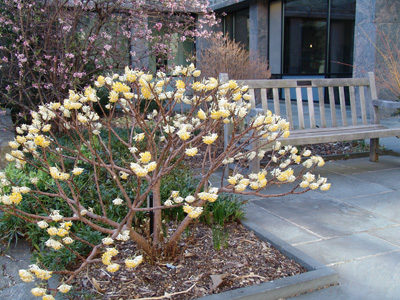
The silky white buds of Edgeworthia chrysantha open to a mass of tubular yellow fragrant flower. photo credit: R. Maurer
March Edgeworthia chrysantha – This is my favorite shrub for early spring flowering. In late March, the silky white buds will open revealing masses of tubular yellow fragrant flowers.
April Fothergilla gardenii ‘Suzanne’ – ‘Suzanne’ is a diminutive selection of the fothergilla. Before the leaves emerge, this shrub is adorned with fragrant, white bottlebrush-like flowers.
May Calycanthus x raulstonii ‘Hartlage Wine’ – ‘Hartlage Wine’ is one of the most exciting shrubs for spring flowers. As the leaves are emerging, this Calycanthus is covered in large open-faced maroon flowers.
June Hydrangea paniculata Little LimeTM – This is the dwarf version of H. ‘Limelight’, reaching only five feet tall at maturity. In June, cones of lime green flowers will emerge, turning white for the remainder of the summer.
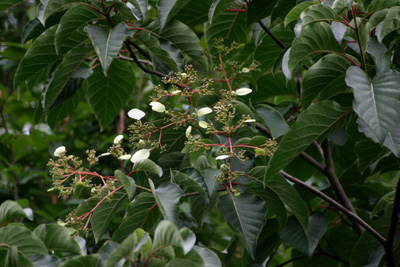
Emmenopterys henryi is a great tree for a show stopping display in July. photo credit: D. Mattis
July Emmenopterys henryi – Emmenopterys is an exciting tree for its July flowers. The large white bracts look as if they are hovering above the foliage.
August Lagerstroemia indica [Burgundy Cotton®]=’Whit VI’ – The crepe myrtles are a quintessential summer flowering tree. This new selection contrasts beautifully its purple-black foliage with white flowers.
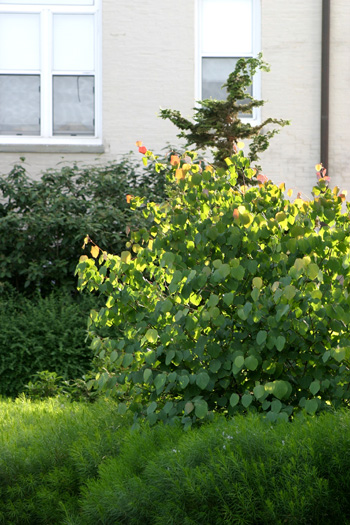
Disanthus cercidifolius' heart-shaped leaves backlit by the setting sun. photo credit: D. Mattis
Fall Color Disanthus cercidifolius – Many shrubs have outstanding fall color. Disanthus has spectacular fall color. Depending on the siting, the heart-shaped leaves can vary from fire engine-red to reddish purple.
Late Fall Ilex verticillata ‘Maryland Beauty’ – ‘Maryland Beauty’ is one of the finest clones of winterberry hollies. From September to March the branches are heavily laden with cherry–red berries.
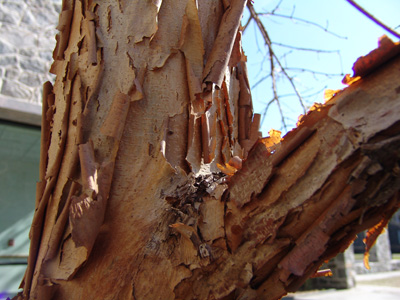
The attractive bark of Acer triflorum provides winter interest in your garden. photo credit: R. Maurer
Winter Our gardens do not end with a killing frost. There are many plants that continue to provide interest on through the winter, including those with attractive bark, like Acer triflorum. This small maple has a depth of orange-brown colors in its flaking bark and makes a great specimen tree.
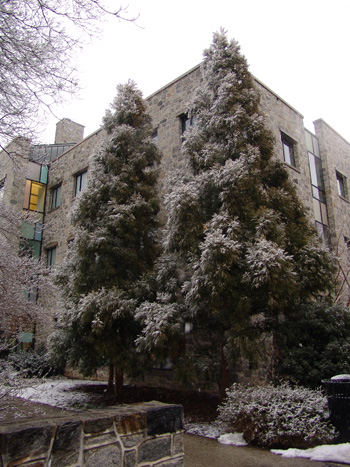
Crytomeria japonica 'Yoshino' attractive pyramidal shape looks lovely with this light dusting of snow. photo credit: R. Robert
Of course, conifers stand out in winter, and Cryptomeria japonica ‘Yoshino’ is a great choice. This cultivar of Japanese cedar holds its color well in winter, has a strong pyramidal shape, and sheds snow well. It grows tall and fast in the sun, but will also perform in shade, just growing more slowly.
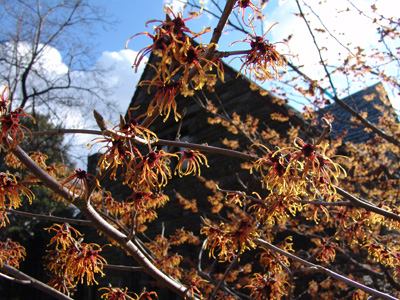
The eye-catching flower display of Hamamelis x intermedia 'Jelena' adds to your winter garden. photo credit: R. Manduca
However, our discussionis about eye-catching flower displays, and there are plants to brighten up the dead of winter with blooms—witchhazels, in particular. Hamamelis x intermedia ‘Jelena’ is a great choice. It has a copper-colored flower, rewarding close inspection because it’s also fragrant. ‘Jelena’ generally sheds last-season’s leaves, so those blooms are not obscured, which happens with some witchhazels.
You can get full descriptive and cultural information on the plants Andrew mentioned from the Plant Sale Handbook. All these plants will be available for sale at the 2011 Scott Associates Plant Sale.
Another good resource to help you plot peak bloom times is this table at the Missouri Botanical Garden website. The calendar charts blooming for their area of the Midwest, but their USDA hardiness is comparable to our region.
==================== >< ===================
Ted Patterson, from Wayne, PA, retired from public relations work with the U.S. Dept. of Agriculture, is a co-chair of the woody plant section at the Scott Associates Plant Sale.





Jan Goren
Posted at 18:04h, 17 SeptemberNice article Ted.
Jan Goren
Posted at 18:04h, 17 SeptemberNice article Ted
Barbara Shaw
Posted at 13:28h, 25 SeptemberGreat article. Love it.